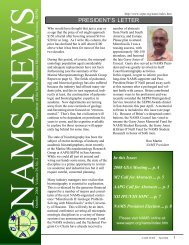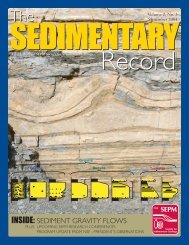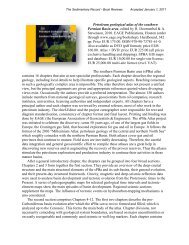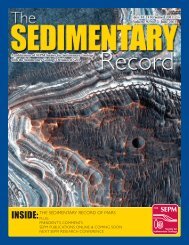PDF of contents and abstracts - SEPM
PDF of contents and abstracts - SEPM
PDF of contents and abstracts - SEPM
Create successful ePaper yourself
Turn your PDF publications into a flip-book with our unique Google optimized e-Paper software.
A PEDOSTRATIGRAPHIC APPROACH TO NONMARINE SEQUENCE<br />
STRATIGRAPHY: A THREE-DIMENSIONAL PALEOSOL-LANDSCAPE<br />
MODEL FROM THE CRETACEOUS (CENOMANIAN) DUNVEGAN<br />
FORMATION, ALBERTA AND BRITISH COLUMBIA, CANADA<br />
PAUL J. MCCARTHY<br />
Department <strong>of</strong> Geology & Geophysics <strong>and</strong> Geophysical Institute, University <strong>of</strong> Alaska,<br />
Fairbanks, Alaska 99775-5780<br />
e-mail: pjmccarthy@alaska.edu<br />
AND<br />
A. GUY PLINT<br />
Department <strong>of</strong> Earth Sciences, The University <strong>of</strong> Western Ontario, London, Ontario, N6A 5B7,<br />
Canada<br />
ABSTRACT: A basin-scale pedostratigraphic model that focuses on paleosols <strong>and</strong> their pedostratigraphic<br />
relationships has been established for the Cenomanian Dunvegan Formation, a unit that represents a large<br />
delta complex. A detailed sequence stratigraphic <strong>and</strong> paleogeographic framework permits analysis <strong>of</strong><br />
paleosol development with respect to distance from marine shorelines <strong>and</strong> coeval valleys. Paleosols that<br />
bracket sequence boundaries vary depending upon their paleo-l<strong>and</strong>scape position. The sequence-bounding<br />
package <strong>of</strong> paleosols can be partitioned into three spatial zones based upon both the degree <strong>of</strong><br />
development <strong>and</strong> the architecture <strong>of</strong> the paleosols. Zone 1 occurs in seaward localities near the maximum<br />
regressive shoreline <strong>and</strong> is characterized by hydromorphic, weakly developed paleosols typical <strong>of</strong> a<br />
poorly drained, progradational, <strong>and</strong> aggradational coastal plain. Zone 2 occurs in an intermediate location<br />
<strong>and</strong> is characterized by well-developed Alfisol-like welded paleosols that record a complex architecture<br />
indicating (i) an aggradational phase; (ii) a subsequent static <strong>and</strong>/or degradational phase related to valley<br />
incision, nondeposition, <strong>and</strong> soil thickening; <strong>and</strong> (iii) a final aggradational phase related to valley filling<br />
<strong>and</strong> renewed sedimentation across the coastal plain. Zone 3 occurs in more up-dip settings <strong>and</strong> is<br />
characterized by compound <strong>and</strong> complex Inceptisol-like paleosols that developed as the result <strong>of</strong> a<br />
reduced aggradation rate when valleys were being incised further down-dip. Because accommodation,<br />
sediment supply, <strong>and</strong> hydrological conditions vary in both dip <strong>and</strong> strike directions, the three zones<br />
represent lateral soil facies equivalents. The soil-forming interval bracketing the sequence boundary<br />
comprises a geosol composed <strong>of</strong> welded paleosols that subdivide both up-dip <strong>and</strong> down-dip into more<br />
weakly developed aggradational paleosol complexes. Above the sequence boundary, a high<br />
accommodation phase (equivalent to the Transgressive Systems Tract) is represented by widespread<br />
lacustrine <strong>and</strong> poorly drained floodplain facies <strong>and</strong> weakly developed hydromorphic paleosols. As<br />
accommodation rate decreases (late Highst<strong>and</strong> Systems Tract time) the alluvial succession becomes<br />
paleosol dominated, comprising floodplain pedocomplexes that record a regional decrease in the<br />
accommodation/sediment supply ratio. Up-dip variability along the sequence boundary <strong>and</strong> within<br />
sequences is controlled primarily by variations in the accommodation/sediment supply ratio, by<br />
hydrological variations associated with floodplain incision during valley formation, <strong>and</strong> by tectonic<br />
subsidence rates that vary in space <strong>and</strong> in time.






